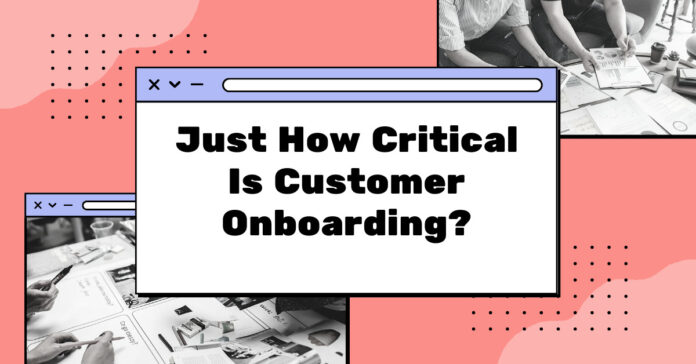Sometimes, many businesses fall short with the customer journey regarding customer onboarding. They feel that enough resources have been allocated to get the customer to sign the contract deal, install the product, follow the instructions, and that’s it.
Money collected and time to move on. Yet these days, there’s a lot of heavy competition, especially in the era of Software as a Service (SaaS) options.
Customers can sign up for one software, and when they feel their needs aren’t being met, export their data and move on to the next one, which will surely have import features.
That’s why when it comes to customer onboarding, it continues well after the user has paid or closed the deal.
Table of Contents
Why Bother With Customer Onboarding Post-Sale?
There’s actual data available that indicates most customers will abandon a product if the customer onboarding experience falls below expectations.
It’s not just that one piece, of course, and that expands into areas such as customer success management and the right fit for the customer.
READ ALSO: Everything You Need To Know About Using A VPN
Retention
With a properly developed customer onboarding process, you’ll start beating the statistic of customers leaving and start focusing on keeping those customers.
Onboarding provides more than just training; it also offers a level of continual support and guidance that keeps the user well-engaged in the early days and utilizing the product or service to its maximum potential.
Then, when customers fully utilize the product, they’re most likely to continue using it long-term because of its essential nature.
More Revenue
With superb customer onboarding, the business will thrive in multiple ways. First, the user themselves will start moving along the customer journey and become advocates for the product, helping to sell it indirectly through their recommendations.
Another channel is existing customers will expand their service level (to a higher, more expensive tier) or buy relevant additional products.
And finally, simply keeping customers on a subscription-based service and focusing on reducing customer churn will keep those customers generating a healthy flow of revenue.
READ ALSO: How Identity Document Verification Services Can Help You Build Trust
Cost-Effective
Customer onboarding is a worthwhile investment because it helps to ensure that the costs used to acquire a customer are well spent. After all, they stay a customer. Therefore, the longer they stay a customer, the lower the cost per acquisition becomes as well.
In addition, since proper customer onboarding includes training, guides, and support, it requires less investment in actual customer support due to the product’s intuitive design, and the onboarding experience addresses any and all questions early on.
In fact, with the early users of a product and extensive onboarding, those early users typically become the trainers themselves, with a train-the-trainer mentality.
Where to Start?
Customer onboarding isn’t a mysterious strategy that’s difficult to master. It is, in fact, something that any company can and should implement. It all starts with a well-defined client journey, and every touchpoint a customer has, from lead to acquisition to customer onboarding, should feel like a unified effort, with training along the way.
Yet it’s key to note that customer onboarding isn’t a one-size-fits-all solution these days, meaning you’ll have to develop user personas and build out the right type of customer onboarding based on those personas.
That means if you’re selling a whole system with CRM and Accounting software, the customer onboarding will look a lot different for the finance department versus the sales department.
Again, it’s about understanding their pain points and how the product helps alleviate those pain points and allows the user persona to work more efficiently.
Then there are those who prefer a hands-on, guided approach, while others want a more automated approach with all the reference materials, training, and guides sent for them to review at their own pace.
The customer onboarding process is critical to retaining customers, reducing churn, and ultimately working on healthier revenue generation. The more focus and personalization you’re able to develop for customer onboarding, the better feedback you’ll receive.
READ ALSO: Third-Party Access: Where Friction Becomes Risk
Just How Critical Is Customer Onboarding? FAQs
Why is customer onboarding so important?
Customer onboarding is crucial for several reasons:
- Reduces churn: Effective onboarding helps users achieve value quickly, increasing their satisfaction and reducing the likelihood they’ll abandon your product or service.
- Boosts lifetime value: Onboarded users become more engaged and utilize more features, leading to higher revenue and profitability over time.
- Builds brand loyalty: Positive onboarding experiences cultivate positive brand perception and encourage long-term relationships with customers.
- Improves user adoption: Clear and well-structured onboarding accelerates user understanding and adoption of your product’s features.
What are the biggest mistakes companies make in onboarding?
Common mistakes include:
- Generic and impersonal experience: One-size-fits-all onboarding doesn’t cater to individual user needs and preferences.
- Lack of clear goals and expectations: Users should understand what they’ll achieve by completing the onboarding process.
- Complex and overwhelming processes: Too many steps or confusing instructions can frustrate users and lead to abandonment.
- Focusing on features instead of benefits: Explain how features solve user problems and address their specific needs.
- Inadequate support and guidance: Leave users feeling lost without readily available resources or assistance.
READ ALSO: How To Streamline The Customer Journey With Omnichannel Integration
What are some key elements of a successful onboarding process?
- Personalization: Cater to different user types and goals with tailored content and experiences.
- Simple and user-friendly: Prioritize intuitive navigation and clear instructions.
- Engaging and interactive: Use multimedia elements, quizzes, and progress tracking to keep users engaged.
- Value-driven: Focus on helping users achieve their desired outcomes quickly.
- Continuous feedback and improvement: Gather feedback from users and update your onboarding based on their needs.
READ ALSO: How to Monetize Your Mobile App Effectively
How can you measure the effectiveness of your onboarding program?
Track key metrics like:
- Completion rates: Measure the percentage of users completing onboarding steps.
- Time to value: Track how long it takes users to achieve their first meaningful goal.
- User engagement: Monitor key metrics, such as feature usage and interactions within the product.
- Customer satisfaction: Conduct surveys and collect feedback on the onboarding experience.
By analyzing these metrics, you can identify areas for improvement and optimize your onboarding process for even greater success.
A Final Word
Remember, effective customer onboarding is an investment that pays off in the long run by fostering stronger relationships, driving revenue growth, and enhancing user satisfaction.
INTERESTING POSTS
- Integrating Security Awareness Training Into Employee Onboarding
- 5 Software Tools to Help You Improve Your Business Processes
- Evolving VPN giant: CyberGhost to acquire PIA for $95.5 million
- Cybersecurity is the responsibility of Agencies, not ours – ASD and AGD
- How To Start A Cybersecurity Company
- The Value Of Software Product Risk Assessment
- The Role Of Data Retention Policies In Cybersecurity Preparedness
About the Author:
Meet Angela Daniel, an esteemed cybersecurity expert and the Associate Editor at SecureBlitz. With a profound understanding of the digital security landscape, Angela is dedicated to sharing her wealth of knowledge with readers. Her insightful articles delve into the intricacies of cybersecurity, offering a beacon of understanding in the ever-evolving realm of online safety.
Angela's expertise is grounded in a passion for staying at the forefront of emerging threats and protective measures. Her commitment to empowering individuals and organizations with the tools and insights to safeguard their digital presence is unwavering.









